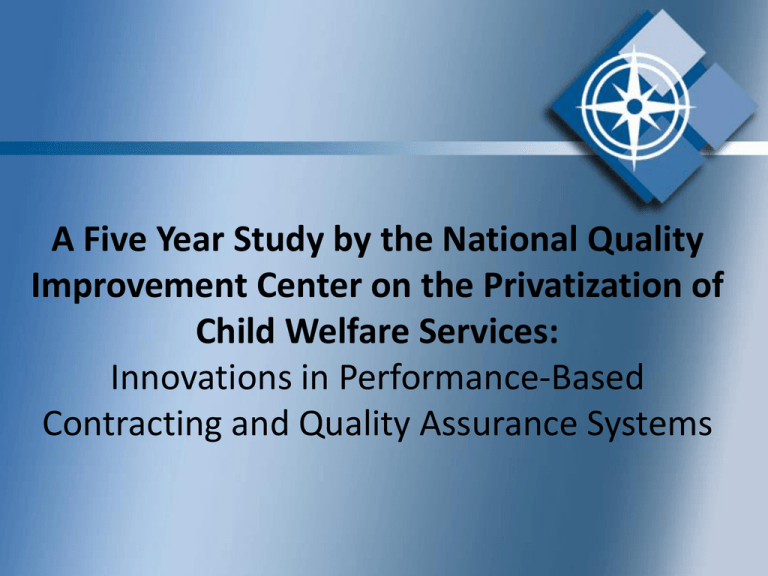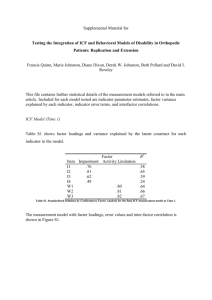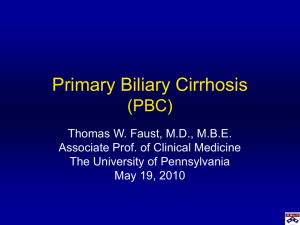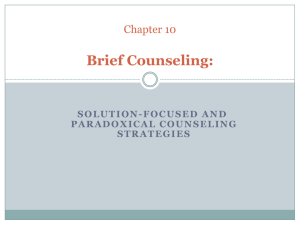Public Private Partnerships in Child Welfare: What Have We Learned
advertisement

A Five Year Study by the National Quality Improvement Center on the Privatization of Child Welfare Services: Innovations in Performance-Based Contracting and Quality Assurance Systems Presenters Crystal Collins-Camargo University of Louisville QIC PCW Director Jennifer Hall University of Kentucky QIC PCW Project Manager Presentation Outline •Overview of QIC Concept, Purpose & Goals •Selection of Topic: PBC/QA •Foundation of Promising Practices •Status of Privatization & Use of PBC •Findings from the Cross-Site Evaluation •Lessons Learned & Conclusions The Quality Improvement Concept The QIC PCW continues the experiment by the Children’s Bureau to utilize QICs as a method of research and demonstration •evidence-based topic selection •rigorous evaluation •targeted TA •broad dissemination This is a knowledge development initiative—the goal is to move the child welfare field forward Funded by the Children’s Bureau, the QIC PCW has the following goals: •To promote and support an evidence-based and outcomesfocused approach to child welfare system development and organizational improvement. •To facilitate a collaborative information-sharing and problem-solving national network among subgrantees, the Children’s Bureau’s training and technical assistance network, public child welfare agencies, private service providers, and other stakeholders. •To build consensus on appropriate models of reform, the respective roles and responsibilities of public and private agencies, and to provide input on areas on which the child welfare policy and evaluation fields should focus. Four Components Over Two Distinct Phases Phase I (Year 1) • Conducting a national needs assessment to identify knowledge gaps and assess the current status of privatization efforts • Identification of research questions to be answered through demonstration subgrants in subsequent years Phase II (Years 2-5) • Administering subgrants and providing TA • Evaluating process and outcomes • Disseminating knowledge and facilitating an information-sharing consortium Triangulation of Data Led to Selection of Topical Focus Area for Sub-grants Initial NAB/CB Discussions Key Informant Discussions with PCW Administrators Discussions with Stakeholder Groups Targeted Forums with Experienced States Literature Review Test innovative performance based contracting and quality assurance systems’ ability to promote: – CW outcomes – Quality service delivery – Accountability – Collaboration Promising Practices Worthy of Evaluation re: Contribution to Outcome Achievement Articulation of a shared vision that drives the initiative and is grounded in desired outcomes; Inclusive planning and contract components development process that involves both public and private providers, administrative and practice level staff; Engagement of key external entities, and particularly the courts, tribes and community-based agencies, which play a critical role in provider achievement of performance indicators, and the working relationship between the public and private workers on the frontline; Promising Practices Worthy of Evaluation re: Contribution to Outcome Achievement Implementation of the contract monitoring process that balances appropriate levels of systemic and case level review without micromanagement; Quality assurance and positive outcome-seeking systems of utilization management, that engage administrative and field staff in creative analysis of practice and outcome data, linking cost effectiveness with evidence-based practice on the frontline that best promotes desired outcomes for families and children; and, On-going communication and management of the relationship between the public and private sectors that strives for true partnership in serving families and children, while recognizing the realities of the contractual relationship. 2006 Key Informant Discussions with 45 Public Child Welfare Administrators • Small number engaged in outsourcing significant proportions of service array including primary case management (10%) • Some states have pilot or smaller scale privatization of case management (20%) • The largest group of states rely on traditional contracting arrangements -- public agency workers have primary case management responsibility (70%) 9 have discontinued initiatives 35% no interest in privatization at this time Follow Up: 2008 Key Informant Discussions with 47 Public Child Welfare Administrators Focused on both: • Transferring primary case management to private providers • Using performance based contracts Findings: •17 out of 47 states report having contracts for direct child welfare services where the private agency had primary case management authority 6 States reported large scale efforts Privatized Services • Foster Care • Other Services – Majority – Adoptions • Illinois • Kansas – Florida • Kansas • Michigan – Milwaukee, WI • New York • Maryland • Alternative Response – Limited – Post-adoptions – Maine • Colorado • New York – Hennepin County, MN • District of – Independent Columbia • Prevention Living • Michigan – Michigan • Franklin • Missouri County, Ohio – New York • Nebraska – Residential • In-home Services Services • Ohio – Franklin County, Ohio • Michigan • South Dakota – Areas in Idaho • Tennessee • All services, except investigations – Kansas Future Plans for Privatization • 6 states indicated they are researching efforts and considering privatization of some case management • 5 additional states discussed some interest in expanding the use of private providers Performance Based Contracting • Definition supplied to participants These contracts specify expected levels of performance, most commonly in the way of service or client outcomes and may tie at least a portion of the contractor’s payment, as well as any contract extension or renewal, to their achievement • Definition of PBC appears to vary by state •25 out of 47 state level informants reported some form of PBC being used with varying approaches Examples of Services with PBC • All Services: ID, WI-BMCW • Prevention NY, CO, WY • Counseling/ Therapy: IN • Foster Care: IL, OH, TN, NE • Independent Living KY, WA • Foster Care Recruitment: AZ, MN, ND • Home Studies: MN • Residential Services/ Treatment: IN, WY • Other: MN • Adoption/ Subsidized Adoption: WI, ND Future Plans • 24 States currently implementing have plans to refine, continue or expand the use of PBC • 11 States not currently implementing PBC are considering moving toward this type of contracting in the future The Funded PBC/QA Projects Florida Department of Children and Families Judicial Circuit 5, Kids Central, Inc. and J. K. Elder & Associates Illinois Department of Children and Family Services Child Care Association of Illinois and the University of Illinois at Urbana-Champaign Missouri Children’s Division, Seven consortia of private children’s agencies and the University of Missouri-Columbia Three Demonstration Sites: Florida, Illinois, Missouri Different PBC/QA Interventions Across Sites Different Designs Across Sites Different Outcomes Across Sites • Case management – FL & MO • Residential - IL • Public/Private Structure • Contract Specifications – Incentive/Penalties • Quality Assurance Systems • Organizational or System Supports • Multi-county contractors vs comparison - FL • 3 Regional private contractors vs public mirror sites vs public agency + random case assignment – MO • State-wide private contractors - IL • Process & Practice outcomes – FL • CFSR outcomes – MO • Treatment & Discharge outcomes - IL Cross-Site Evaluation Research Questions RQ1: Does an inclusive and comprehensive planning process produce broad scale buy-in to clearly defined PBC/QA? RQ2: What are the necessary components of PBC/QA systems that promote the greatest improvements in outcomes for children and families? RQ3: When operating under a PBC/QA system, are the child, family and system outcomes produced by private contractors better than those under the previous contracting system? RQ4: Are there essential contextual variables that independently appear to promote contract and system performance? RQ5: Once initially implemented, how do program features and contract monitoring systems evolve over time to ensure continued success? Outcome Performance Analysis • Two time points of complete data from all sites and referred to as Year 1 (FY2008) and Year 2 (FY2009) • Contract outcomes include a variety of measures: % of agency staff who complete required tasks in quality manner - FL % of children who are safe, achieve permanency, or re-enter care - MO # of treatment days youth remain in agency care - IL; % of children sustained in a favorable step-down discharge for 90 days • Analyze the percentage change from Year 1 to Year 2 to determine if there is a significant difference. • Assess the extent to which agencies are able to meet their contract targets for outcomes. • Assess whether performance under PBC across sites improvement over the course of project and whether agencies got better at meeting their contract targets. • Comparison group and pre-PBC data is not available for all sites, thus this analysis focused only on intervention site change over time post-PBC Across all outcomes and sites, does performance improve or decline? Percentage of Change in Performance Across Outcomes: Percentage change = Mean Time 1 performance on all outcomes / (Mean Time 1 Performance on all outcomes – Mean Time 2 Performance on all outcomes ) Note: * Percentages are significantly different from 0 at p<.05 Summary: Change in Performance Over Time •Raw data from each site shows that for the majority of outcomes, outcome performance by contractors improved from Y1 to Y2 under PBC • Analyzing that data to determine if this change was significantly different from 0 showed that while all sites showed degrees of positive change over time, Illinois’ was the only one that was significant. • However, the overall percentage of change from Y1 to Y2 across all outcomes and all sites is 19% which is significantly different from 0. Are agencies able to better meet outcome targets specified in PBCs? Percentage of Agencies Meeting Their Contract Targets Over Time How did public/private partnerships work together to achieve these outcomes using performance-based contracts? Qualitative Data Collection Site Visits Document Review Focus Group • 2 visits per year • 2007-2010 • Focused discussion on implementation, evaluation, outcomes, process • Continuously gathered and reviewed • Meeting minutes • Planning documents • Evaluation findings • Site reports • Contracts and modifications • Two sets of focus groups (2009 & 2010) • First with key stakeholders focused on PBC implementation & process • Second with front-line staff and supervisors focused on communication about PBC, practice changes, use of data, supports for outcomes Key Informant Interviews • Conducted at end of project (late 2009 & early 2010) • One-on-one interviews with key leadership and staff • Reflection on planning process, communication & collaboration, practice change, use of data, PBC/QA structure & system, impact, lessons learned Common Elements for Success Across Sites Political Right Time and Support for Change Leadership Right Leaders Driving Change & Staying Involved Collaboration Inclusive Planning Process Between Public & Private Planning Sufficient Time to Plan Formalized, Transparent Communication Structure Communication Meaningful Feedback to All Levels Practice Support for Practice Change Data Having and Using Reliable Data QA/QI Restructuring QA/QI Process to Support PBC Outcomes Selecting Right Outcomes and Building a Contract Around Them Site-Specific Supports for Achieving Success FLORIDA •Neutral Facilitator Collaboration Support ILLINOIS •Provider Forums & Info Dissemination •Supervisory Roundtable MISSOURI •Program Manager Meetings •Issue-Specific Workgroups •Issue-Specific Workgroups •Supervisory Review Tool Outcome Support •Discharge & Transition Protocol •Family Finders •Child Youth Investment Teams (CAYIT) & Centralized Matching •Statewide Practice Summits Practice Support •Child Welfare Advisory Committee (CWAC) Decision Making Support •CEO Meetings •University Research Partnerships Organizational/System Support •Residential Treatment Outcome System (RTOS) Data Support •Random Case Assignment •Data Test Workgroup Quality Assurance Support •Detailed Agency & WorkerSpecific QA Reports •Monitoring Shift to Quality vs Compliance •Joint Public/Private QA/QI Alignment Lessons Learned Across Sites Process •Planned collaboration and communication process structures are critical •Performance-based contracting is an evolutionary process that takes time •If phasing in, need structured plan for new sites using lessons learned from experienced •Use a fidelity checklist for implementation Public/Private Partnerships •Put equal emphasis on reform in both the public and private sectors •All providers are different entities - they don’t operate the same. •May need to be more direct and prescriptive with the private sector Contracts • Collaboratively choose right outcomes to match overall system goals •Develop a longer term plan than the current contract •Marry finance to outcome development at the start •Need fluid peer record review across sectors •Don’t have dual case management system •Be flexible in contracts and allow innovation Data • Develop or modify data collection/tracking system that is robust •Must have reliable and accurate data to measure outcomes/performance Conclusions • Formal public/private partnerships via performance-based contracts and aligned quality assurance systems can lead to improved system and child/family outcomes • This is a data-driven process that requires a robust data system infrastructure and commitment to using outcome evaluation to monitor performance • Additional organizational or system supports can help ensure practice change and outcome attainment • Developing and sustaining collaborative relationship is key to successful planning, implementation, progress, adaptation QIC PCW Contact Information For more information, contact: Crystal Collins-Camargo, Project Director crystal.collinscamargo@louisville.edu Jennifer Hall, Project Manager jghall2@uky.edu Teri Garstka, Lead Cross-Site Evaluator garstka@ku.edu http://uky.edu/socialwork/qicpcw











